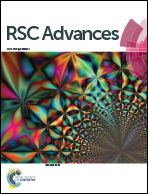Influence of biomaterial nanotopography on the adhesive and elastic properties of Staphylococcus aureus cells†
Abstract
Despite the well-known beneficial effects of biomaterial nanopatterning on host tissue integration, the influence of controlled nanoscale topography on bacterial colonisation and infection remains unknown. Therefore, the aim of the present study was to determine the nanoscale effect of surface nanopatterning on biomaterial colonisation by S. aureus, utilising AFM nanomechanics and single-cell force spectroscopy (SCFS). Nanoindentation of S. aureus bound to planar (PL) and nanopatterned (SQ) polycarbonate (PC) surfaces suggested two distinct areas of mechanical properties, consistent with a central bacterial cell surrounded by a capsullar component. Nevertheless, no differences in elastic moduli were found between bacteria bound to PL and SQ, suggesting a minor role of nanopatterning in bacterial cell elasticity. Furthermore, SCFS demonstrated increased adhesion forces and work between S. aureus and SQ surfaces at 0 s and 1 s contact times. Although WLC modelling showed similarities in contour lengths for attachment to both surfaces, Poisson analysis suggests increased short-range forces for the S. aureus–SQ interactions. In the case of S. aureus–PL, long-range forces were found to not only be dominant but also repulsive in nature, which may help explain the reduced adhesion forces observed during AFM probing. In conclusion, although surface nanopatterning does not significantly influence the elasticity of attached bacterial cells, it was found to promote the early-adhesion of S. aureus cells to the biomaterial surface.



 Please wait while we load your content...
Please wait while we load your content...